I hear the terminology for different muzzle devices misused and mangled frequently. As in…a lot. And it’s not just newbies who are guilty of mis-identifying these things. Plenty of “gun guys” don’t really know the difference.
So to help alleviate the problem and clear up some confusion, here’s the difference between the most commonly used muzzle devices in use today.
Flash Hider

When you buy an AR-15, or any modern rifle with a threaded barrel, the default muzzle device is typically some kind of flash hider. It’s the standard-issue muzzle device for the M16 and M-4 rifles in the U.S. military, and it’s what the gun companies tend to use by default as well.
The idea behind a flash hider (or flash suppressor) is pretty simple to understand. When a gun fires a round of ammunition — especially a carbine like the AR-15 — most of the powder is burned inside the barrel and used to propel the bullet downrange. However, most popular AR-pattern rifles are sold with 16-inch long barrels. Since the 5.56 NATO cartridge was designed to completely burn its powder in a 20-inch barrel, that leaves four missing inches worth of unburnt powder left over after the projectile is gone.
That unburnt powder combusts as soon as it clears the end of the barrel, which results in a good size fireball that’s very visible. That’s bad for military use, but even for civilian shooters, that flash signature has a tendency to obscure the sights, ruin low light or night vision, and make follow-up shots more difficult.
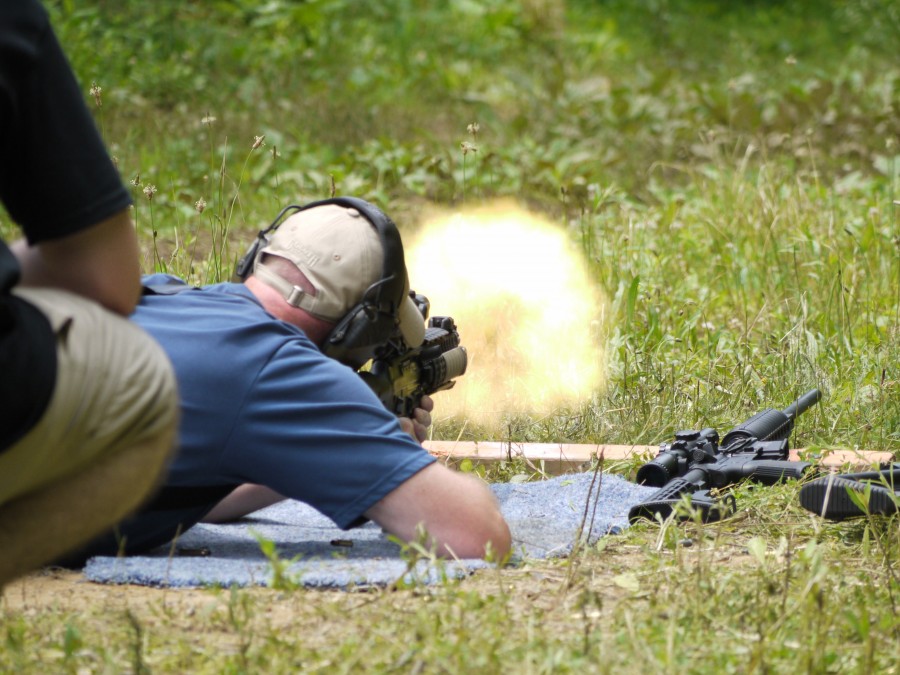
A flash hider works by efficiently mixing the air and the unburnt powder at the end of the muzzle in such a way that there is little or no flash. To understand exactly how it does that requires knowledge of of fluid dynamics and chemistry, a background that I lack. But you can see that it works by comparing a gun with a flash hider with one that only has a bare muzzle.
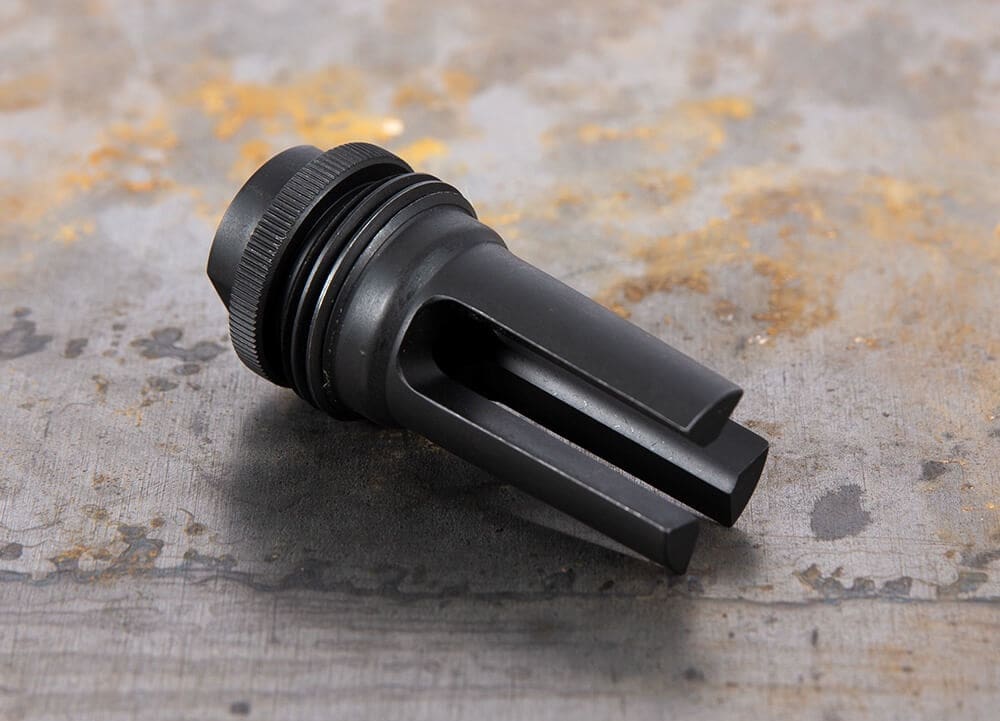
There are lots of different kinds of flash hider desiogns, and the most efficient are those with three prongs. Whether manufactured by Surefire, SilencerCo, Wilson Combat, or Palmetto State Armory, they all make that visible flash disappear pretty efficiently.
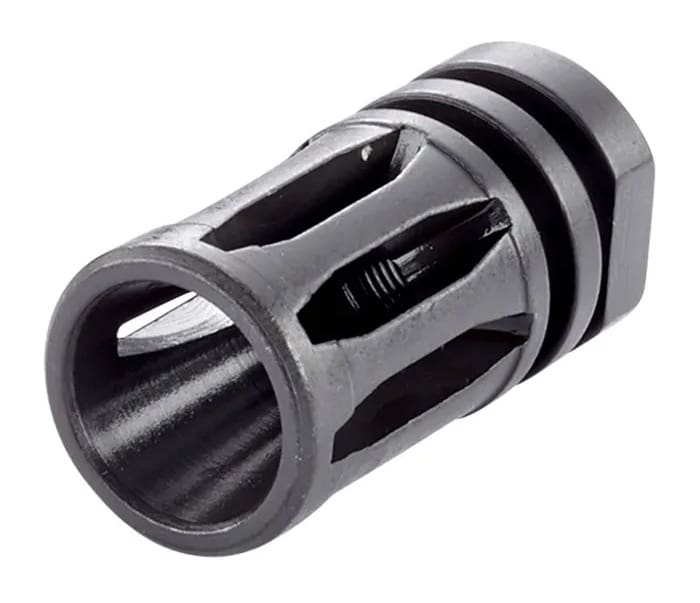
The standard A2 “birdcage” flash hider that’s used on most AR-15 rifles is also pretty efficient, but the real reason why it’s used is that it’s a combination flash hider and compensator.
Want flash suppression data on different devices? Check out Jeremy’s first flash hider roundup here, and the second one here.
Compensator
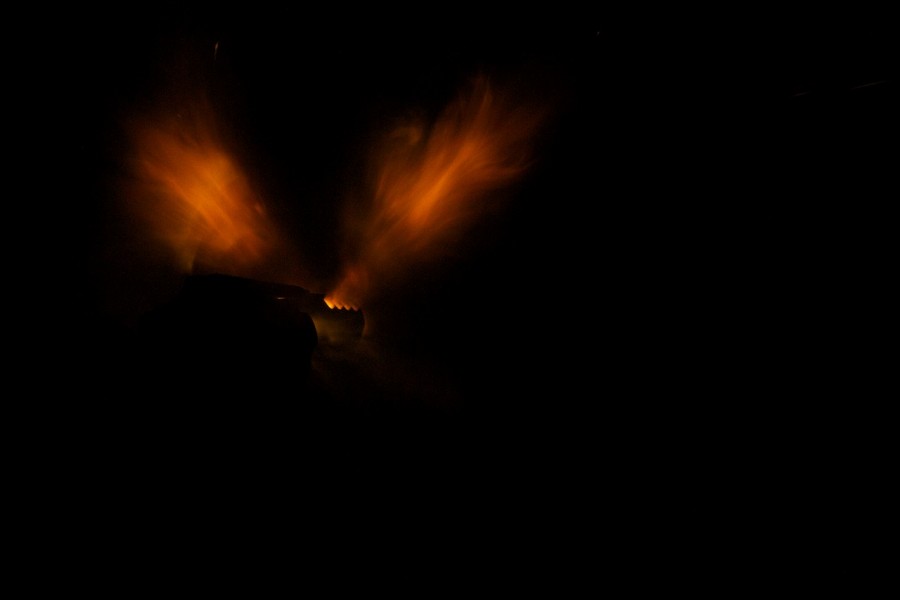
A compensator or “comp” is a muzzle device designed to counter (or compensate for) the vertical rise of the barrel when the gun is fired. The body mechanics involved in firing a gun means that there’s a good bit of muzzle rise or “flip” when the gun goes bang, an effect where the recoil of the gun is translated into the muzzle climbing vertically.
In order to counter that muzzle rise effect, a compensator vents some of the gasses that escape from the barrel vertically. As we remember from physics, every action has an equal but opposite reaction. So the vertically vented gasses have the effect of forcing the muzzle back down, keeping it on target.

The A2 birdcage flash hider on an M16 or AR-15 rifle has cuts on the top of the device that vent the gas and look like, well, a bird cage. The bottom of the device is solid with no cutouts. Not only does this keep the muzzle blast from kicking up much dust, it also provides a solid surface against which the gasses can push to force the muzzle down, compensating for the natural upward force.
Compensators and flash hiders are great, but they don’t do a thing to mitigate the felt recoil of the firearm. Larger, hard-hitting calibers like rifles chambered in .50 BMG have a ton of recoil that, if not properly mitigated, can give you a serious jolt.
That’s where the muzzle brake comes into play.
Muzzle Brake
A muzzle brake (not a muzzle break) is designed to take some of the kick out of the gun when it discharges. As the bullet leaves the muzzle, the expanding gasses that follow quickly start escaping along the path of least resistance (concussion) — which usually means slightly to the side and around the bullet.
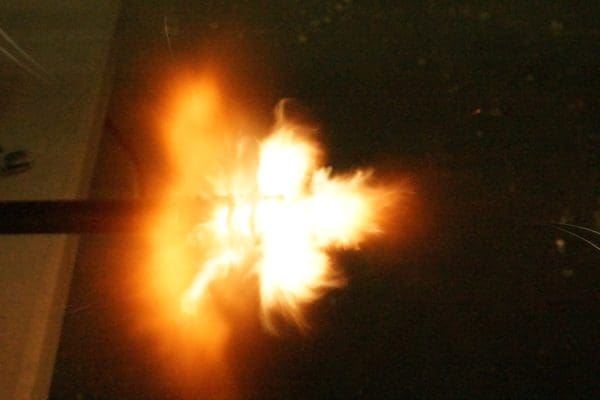
With a muzzle brake, those gasses first hit a solid metal wall before being vented out the sides. Once again the wonders of physics take over, and the force pushing forward on that metal wall moves the gun forward and counteracts some of the rearward force of the gun.
While a brake can vent those gasses in any direction, most brakes vent the gasses to either side of the barrel and not vertically into the line of sight of the shooter. It also creates a pressure wave that moves horizontally along the firing line, often annoying those to either side of the shooter.
Another increasingly popular (though highly regulated) form of muzzle brake is the silencer. The baffles in a can that slow the gasses and turn that loud “BANG” into a more squishy “pffffft” sound also act as a massive muzzle brake, greatly reducing the recoil of the gun.
That’s one of the reasons that a Neilsen device is required on a handgun silencer. It’s spring or piston that allows the barrel to recoil enough to kick the slide back and cycle the semi-automatic action as the silencer itself is being moved forward by the gasses.

Looking for data on which brakes brake the best? Check out Jeremy’s muzzle brake tests. First 5.56 test here, second here, third here. And the .308 test here.
Combination Devices
Naturally, the ideal muzzle device combines one or more of the features of the devices above. That’s why combination devices, like the A2 flash hider or Precision Armament AFAB Hybrid muzzle device, are extremely popular.
The most common muzzle device for competition shooters is the compensating muzzle brake, which reduces vertical muzzle climb and felt recoil without also caring about the visibility of the firearm. As a result, some fantastic muzzle flashes can be seen in the chambers of the device as the gun goes off.
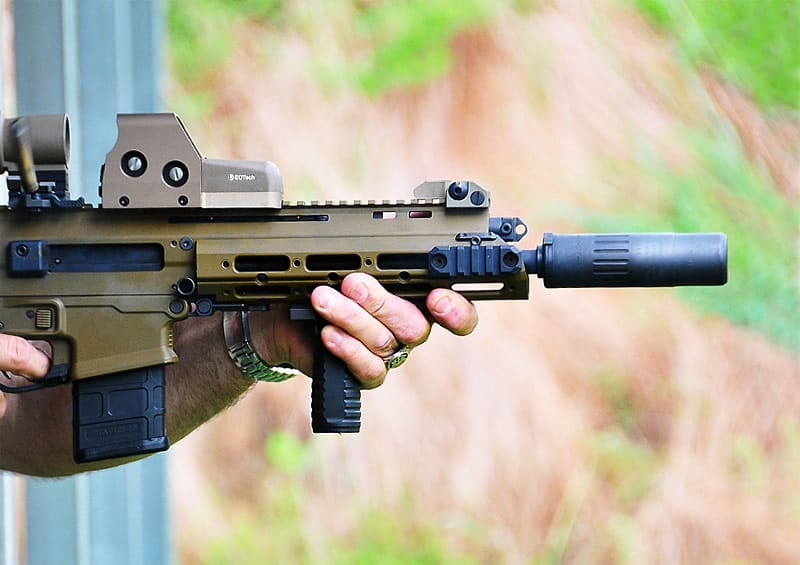
The ideal muzzle device, by almost any measure, is a silencer (AKA a suppressor). It reduces all of the above and does it extremely efficiently. But silencers add some length, are relatively expensive, require the payment of a $200 tax and entail a months-long wait. That’s something lots of gun owners aren’t willing to do.
For me, if I can’t have a silencer, I prefer a straight muzzle brake. Vertical climb is something I can handle with sufficient training, but every little bit of help I can get in the recoil department is always appreciated.





Yeah I can’t have any in ILL annoy. There’s registration of AR’s in this chit state starting today. So the Dims can confiscate your rifle!
Registration, ohhh that ain’t no good. How the Ffff can a state demand registration?
My gunm would probably drowned itself before it got registered.
I typically start any such conversation with “is it allowed here in CA?”
In theory you can have them here so long as it is a manual action or a fixed magazine semi auto. In practice you don’t see them until you exit the city footprints.
It also creates a pressure wave that moves horizontally along the firing line, often annoying those to either side of the shooter.
This.
If you have a muzzle brake on a 5.56 rifle, you are telling everyone on the firing line that you are a wuss every time you pull the trigger. Go to the gym and lift until you don’t need it any more. On a larger caliber rifle, get a recoil pad. It’ll do the same thing without annoying the people around you.
Talk about people that need a gym, you’re bit(hing and moaning about a puff of wind blowing over you.
To what end? Precious snowflakes are gonna melt regardless, just like you’re doing. Get some decent earpro, and man up yourself.
Clearly you are not a 3-gun competitor, or at least not a competitive one.
A flash hider is the pants zipper dacian pulls up quickly when the child says ‘mommy, whats that man doing?”
You win the internet🙄🤓
👍
Doesn’t “Mommy what’s that man doing ?” disqualify lil’ d ?
And a compensator has something to do with penus envy and barrel length
RE: “With a muzzle brake, those gasses first hit a solid metal wall before being vented out the sides.”
Inside attached 5.56, .308 A2 Hiders there is an open space between the barrel crown and the hider bore that creates such a wall. The space if not routinely cleaned can collect fouling.
Hmmm… I did not realise that Deb, in spite of the number of times I’ve cleaned my rifles.. most of which have flash suppressors. Aware of the difference between the cages of A1 and A2 suppressors but not their actual construction..
Everybody might not know that though. Just like I did not know the gasses hit a solid metal wall, I’m puzzled as to how the projectile does not deform while passing through that solid wall of metal?
Not a “muzzle break”, unless one is in the NY state legislature trying to cram the SAFE Act through before the public can see it.
https://reason.com/2014/01/02/safe-act-decision-highlights-embarrassin/
Everything is racist to these woke students.
There is one other device. A blast can. It looks like an open ended silencer with no baffles. It directs all of the flash and blast forward. Makes people at the range a little happier with you when using a very short barrel. Unless the echo reverberates back at you all in an indoor range. Outdoors it saves a lot of wear and tear on your ears which thanks to Uncle Sugar I need all the help I can get to keep what I have left.
I thought the birdcage devices were flash suppressors. I also thought flash hiders were the cone shaped devices attached to SMLE jungle carbines and BREN LMG.
Yep, bingo..
Don’t forget the clamp on cone shaped one’s for the M1 carbine.
I forgot something the Beretta BM series of rifles. I used to have a BM-62 with what was called an “expansion chamber.” That thing was next to useless, but the rifle was the finest military rifle I ever touched. Then there was the BM-59 with the tri-compensator. No experience with that.
Is that something along the lines of dacian, the bi-compensator ?
I’ll generally go with a flash hider for most things and consider a compensator if it makes more sense. A brake is more of a specialty item to me.
It all depends. For some things, the choice of muzzle devise is about nothing more than looks.
So much myth and hearsay. The flash mostly comes from superheated high pressure gases, which essentially glow, so unburned powder isn’t the primary issue. The M16s originally had duck bill and three prong flash hider on the 20 inch barrels that “completely byrned” the powder. They changed the shape of the flash from a sphere into a “Y” that was hidden from the shooter’s view. More modern suppressors, like the Vorrtex, mix the hot and ambient gasses to reduce the glow. The 3 prong suppressors kicked up dust in prone position, which is the main reason the bird cage suppressors had a solid bottom. The flaw in the references xomparison article is that the measurements are take. from the side vs uprange/downrange.
The reason the Neilsen devices are needed is to isolate the mass of the suppressor from the reciprocating mass of the slide/barrel (which would proportionally slow the slide velocity) and the torque/moment of inertia of a tipping barrel. Pistols with fixed barrels don’t need them. Suppressors provide expansion volume of the hot gasses, which cools them and lowers the pressure and velocity, which reduces the incandescence, recoil, and sonic impulse.
This is a good reason to use bird cage hiders on longer rifles more likely to be fire in prone and three prong hiders on shorter barrel rifles likely to be fired off hand.
The AR-15 I use most often came with a 20 inch barrel and a birdcage muzzle device. The AR-10 I use most often carries an 18 inch barrel and uses the same type of birdcage device.
The big bore rifles I have are all old enough to not have any type of muzzle device.
None of the handguns I own, with a single exception of an S&W 500 has any type of compensator or muzzle device.
Never considered putting anything out on the muzzle of a rifle before I became acquainted with the M-16 courtesy of Uncle Sugar. Never considered these devices for anything not factory equipped with such.
Would like a suppressor on a couple firearms, but refuse to pay the tax stamp and have anything else on the crap list the BATF doesn’t need to know about than what is already on their list because the law requires it.
The most shocking thing about this article is that Foghorn is still around here.